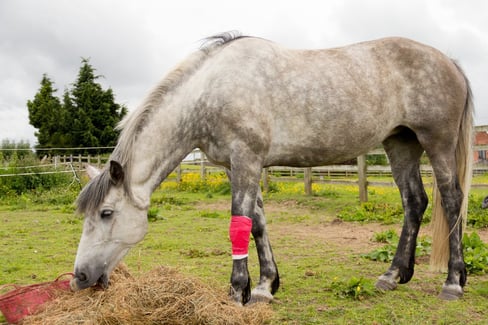Table of Contents
Horse owners are always searching for the best ways to protect their prized animals from injury, disease, and even death. One of the most common yet misunderstood types of injuries is tendon injuries in horses. In order to combat this devastating malady, it is important for horse owners to fully understand what to look for and how to prevent damage.
Let’s get into it so you can steer clear of these painful problems.
Introduction to Tendon Injury Horse
In the equestrian world, tendon injuries have a high rate of occurrence. Knowing where these tendon injuries are most likely to occur and how to handle them if your horse does sustain one, can help save yourself and your horse from years of pain and frustration.
Horses need their tendons and ligaments for movement and support. They also require them to hold up their body weight.
Many different kinds of ligaments and tendon injuries can affect horses. However, three main types happen more frequently than others:
- These are when a horse is injured during exercise or training
- By an accident while in the yard or pasture
- Overuse, or when the horse pulls the tendon
We’ll get into the specifics of each type of injury later, as well as symptoms and treatment for horse tendon injuries later.
Horse Tendon vs. Ligament
There are two types of connective tissue in your horse’s legs: tendons and ligaments. Both play an important role in your horse’s mobility and strength, but they differ in how they work.
Tendons connect muscle to bone and are responsible for movement and force production. A tendon is a very tough band of connective tissue connecting muscles to bones. It is composed of collagen, a protein that does not stretch very much.
Ligaments are bands of connective tissue that either wrap around or connect two bones in order to support and stabilize joints. They are more elastic than tendons. When ligaments and bones are connected , they provide stability to the joint, like a support.
The major difference between tendons and ligaments is their location in the body. Tendons are located on the inside of joints, while ligaments are found outside of joints.
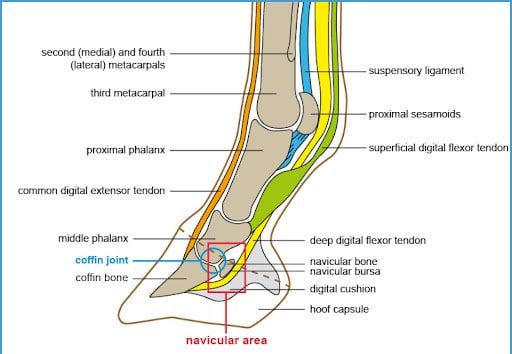
You can see the location differences in the diagram above by comparing the location of the suspensory ligament versus the superficial digital flexor tendon, noted in blue and green, respectively.
We’ll cover the specifics of both the tendons and ligaments you need to watch out for as common pain points for your horse throughout this post, so make yourself familiar with the differences!
Types of Ligaments in Horses
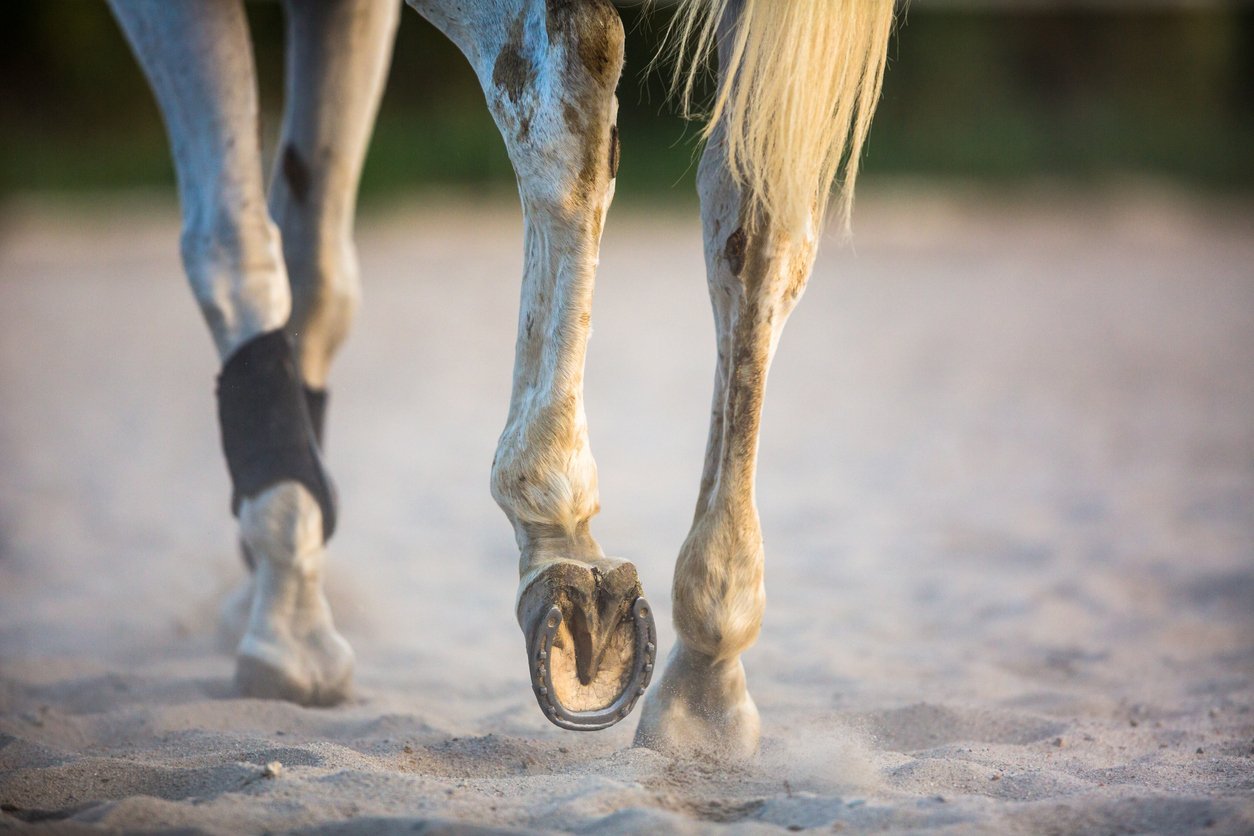
Alright, let’s saddle up and discuss the types of ligaments found in your horse.
There are many ligaments in your horse’s body – from tip to tail and in all of their limbs. But there are seven key ligaments that we will be focusing on today because they are the most key to keep an eye on when it comes to preventing a horse ligament injury.
The key areas to watch for and prevent a horse ligament injury include:
- Check ligament
- Collateral ligament
- Annular ligament
- Palmar annular ligament
- Suspensory ligament
- Straight sesamoidean ligament
- Plantar ligament
Let’s get into the specifics of each ligament so you can get the whole picture.
Check Ligament Horse
Horses have two check ligaments in each front leg and one in each hind leg.
The two check ligaments horses have are:
- Superior check ligament
- Inferior check ligament
The uppermost check ligament attaches the radius (above the knee) to the superficial flexor tendon of the front leg. It is also known as the superior check ligament.
A thin ligament connects the lower carpal bones (below the knee) with the deep flexor tendon at the back. It is known as the inferior check ligament.
Check ligaments are attached to bones instead of muscles and form tendons. Although the deep and superficial flexor tendons originate in the muscle, they also connect to the bone in the upper regions of these structures through the check ligaments.
Check Ligament Horse Anatomy
The diagram below shows the key components of the horse’s limb anatomy, including the superior and inferior check ligaments.
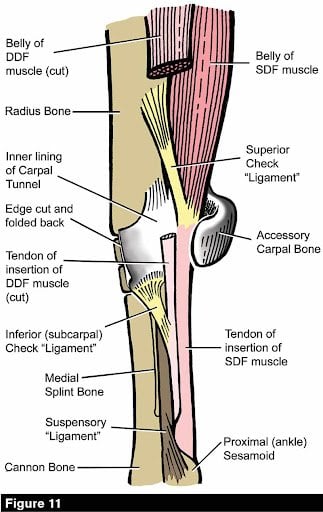
As you can see, the superior check ligament is located above the knee and carpal bones, while the inferior check ligament is much smaller and is located below the knee.
Inferior Check Ligament Horse
The inferior check ligament in a horse is so named for its location lower down or closer to the hoof of a horse.
This ligament is not as commonly injured as other tendons and ligaments in the front limbs, like the suspensory ligament or the flexor tendons – but that doesn’t mean it’s not serious.
For a sport horse especially, such as those who participate in quarter horse racing, it can affect performance and health negatively to injure the inferior check ligament. That’s because this ligament is responsible for shock absorption and prevents excessive tendon lengthening.
All considered, those are really important injury protection-related functions you don’t want impacted!
That’s why keeping ligaments and soft tissues healthy is important to avoid tendon injury horse problems by:
- Offering regular, safe exercise and stretching programs to your horse
- Scheduling regular check ups with the vet
- Examining and feeling the back of the cannon bone, tendons, and ligaments for swelling or heat, especially if lameness is present.
- Feeding a high-quality horse supplement that supports joints and tissues from the inside out with ingredients like glucosamine and chondroitin
Superior Check Ligament Horse
As you might guess, the superior check ligament in a horse is located above the knee. Like its inferior counterpart, this ligament is an accessory ligament to a digital tendon (a tendon that connects and controls the movement of the feet and digits).
The two horse ligaments are connected as such:
- The superficial flexor tendon accessory is the superior check ligament
- The deep flexor tendon accessory ligament is the inferior check ligament
Injuries to any of the interconnected structures can spell pain for your horse. For the superior check ligament, horse pain can arise from a case of tendonitis. This can require a surgery called superior ligament desmotomy.
In this case, you’ll want to watch out for tendon injury horse signs like:
- Inconsistent or intermittent lameness
- Swelling around the area of damage, sometimes with a large lump
- Inflammation-induced heat
- Tenderness when being examined
Always get in touch with your vet when in doubt, and ensure your horse’s diet is well-rounded and includes a muscle, joint, and tissue supporting horse supplement like TRI-ACTA for equine. Glucosamine, chondroitin, and MSM all help make your horse’s tissues and joints strong, well-supported, and ready to run.
TRI-ACTA for Pets
A proactive approach for developing and younger adult pets to maintain optimal joint health mobility, minimize inflammation and fend off age-related ailments.
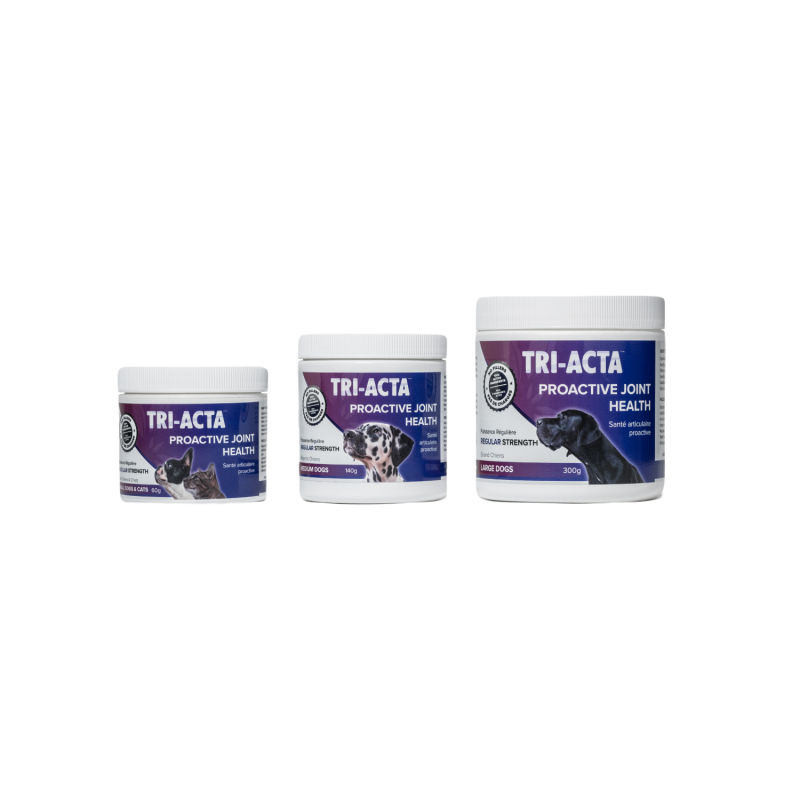
Collateral Ligament Horse
When discussing the collateral ligament in horses, we are talking about a category of ligaments found in various areas of the horse’s limbs. These ligaments support and stabilize the joint flexes and extend through their range of motion.
Key collateral ligaments in horses include:
- Stifle
- Coffin
- Fetlock
- Pastern
- Navicular
- Hock
The diagram below shows some of the key collateral ligaments found in a horse’s foot.
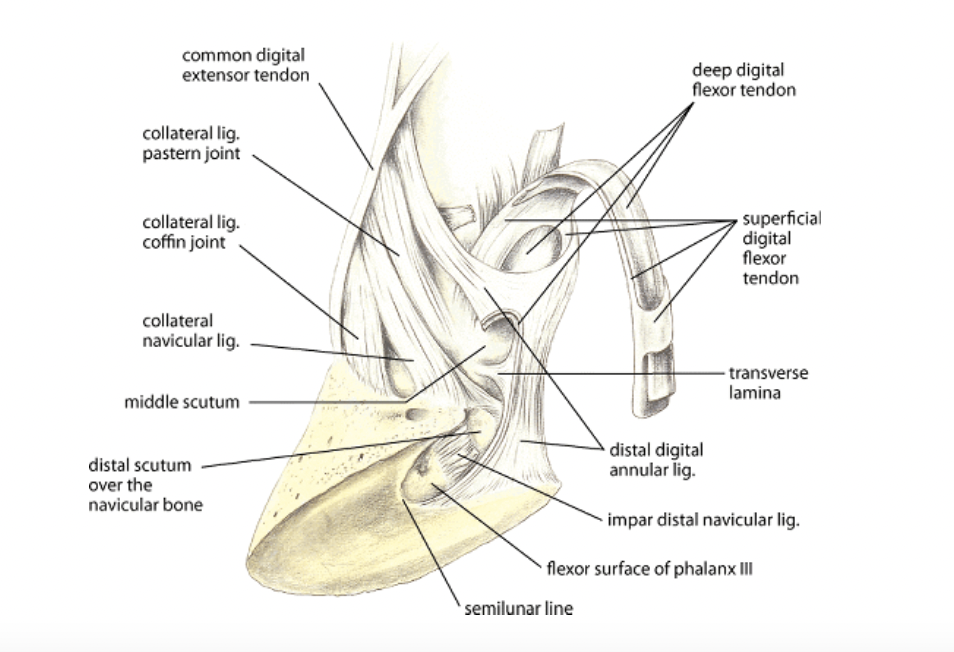
In addition to the horse’s foot, the coffin, fetlock, and hock joints are the most commonly injured collateral ligaments.
These ligaments help ensure your horse can move, flex their limbs in a full range of motion, and are all-around important! Keeping their ligaments and other soft tissues healthy and strong by feeding a horse joint supplement is one way to complement good horse health care like diet and exercise.
Annular Ligament Horse
An annular ligament is a fibrous band that wraps around flexor tendons as they pass over the sesamoid bones of the fetlock on the palmar or plantar surfaces of the foot.
In the diagram below, you can see this sling-like band wrap around the back of the fetlock.
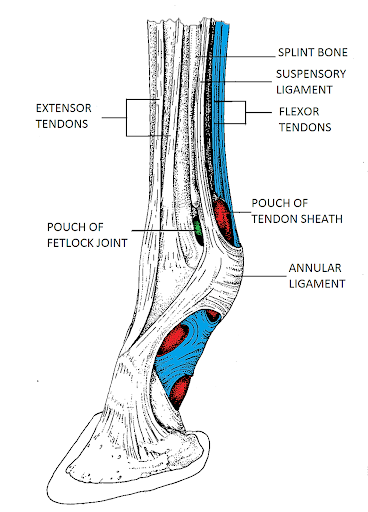
A thickening or degeneration of the annular ligament can also affect the digital sheath and other structures.
Annular ligament syndrome can be primary or secondary:
- Primary cases originate from the plantar annular ligament, typically due to trauma or chronic overstretching
- Secondary cases occur due to pathology within soft tissue structures associated with the palmar annular ligament, such as the digital tendon sheath or flexor tendons
Both result in constriction and interference with the normal smooth movement of the tendons within the fetlock canal, and this stress causes the annular ligament to thicken and enlarge. Call your vet if you’re worried about your equine and annular ligament syndrome.
Suspensory Ligament Horse Hind Leg
Suspensory ligaments support your horse’s fetlock, starting below the knee at the cannon bone and running through the fetlock. They branch out and attach to the sesamoid bones at the ends.
Viewing the diagram below, you can see the horse suspensory ligament’s anatomy.
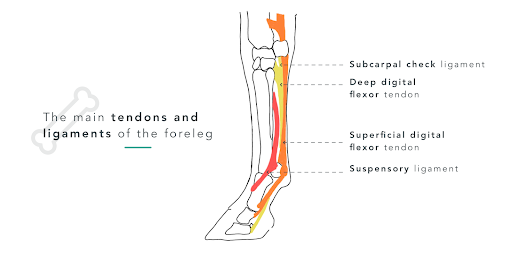
The suspensory ligament ensures that your horse’s fetlock doesn’t drop too low when running, jumping, and even walking. This is called hyperextension, which can be a painful experience for your horse.
Straight Sesamoidean Ligament Horse
Straight sesamoidean ligaments in horses are part of a group of the distal sesamoidean ligaments in a horse’s foot and ankle. When these distal sesamoidean ligaments are injured and cause lameness.
Neigh fun!
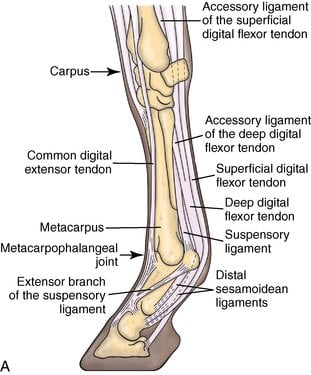
The above diagram shows the distal sesamoidean ligaments in a side view. Based on their proximity and connection to the other key structures, you can see how it would be a pain for your horse to experience an injury.
Horses with an injury to the distal sesamoidean experience:
- Swelling and heat in the area of the pastern region
- Subsequent suspensory ligament injuries
- Soft tissue imaging techniques, like radiography and nuclear scintigraphy, reveal abnormalities in the pastern
- Potential for lameness
If you spot any of the above symptoms, give your veterinarian a call and get your horse seen as soon as you can to avoid serious effects to their mobility.
Plantar Ligament Horse
A long ligament near the hock joint, the plantar tarsal ligament is also sometimes called the long plantar ligament horse. This important component of your horse’s legs runs down the back of the calcaneus, attaching to the back of the lower tarsal bones and the tops of the cannon and splint bones, as you can see in the diagram below.
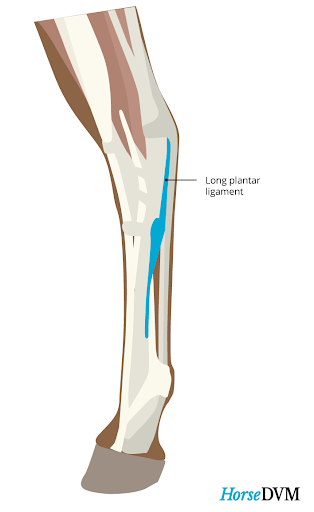
This ligament can become painfully inflamed with a condition called “Curb”, more scientifically known as long plantar desmitis.
Curb triggers inflammation and thickens the ligament, often resulting in a lump on the back of the hock. This is often best seen from a side profile and is often accompanied by acute (sudden onset) lameness. Long plantar desmitis is not just a problem for racehorses but also seems to happen to other kinds of horses, such as Western horses.
That is because Curb can be caused by a number of plantar ligament horse injuries and problems, including:
- As a result of trauma, such as being kicked or kicking a solid object
- An abrupt overextension of the hock (usually caused by sliding stops)
- Constant strain on the ligament due to faulty conformation
Your vet will use a combination of a physical exam and ultrasound.
Curb can be treated with several different techniques and options, as outlined below in the table.
| Therapy for Plantar Ligament Horse Injury | What It Is |
| Extracorporeal shock wave therapy (ESWT) | Usually characterized by very high amplitude and rapid rise time, extracorporeal shock waves are acoustic waves (pressure waves) applied from the outside of your horse’s body. They help heal a variety of soft tissue and bone injuries including plantar ligament horse injuries. Although it is not 100% clear why this works to heal a horse’s tissues, it appears to be a cellular response to the physical shock waves stimulating their cells that can relieve pain and stimulate blood flow in the affected area, while repairing the tissues |
| Horse supplements for tendon injuries | Horse supplements offering glucosamine, chondroitin, and MSM, as well as other joint and soft tissue-supporting ingredients, help ensure your horse has strong and healthy muscles and tendons, and ligaments. |
| Injection of corticosteroids | Injection of corticosteroids can reduce inflammation. Not directly relieving pain, reducing joint inflammation can interrupt the joint-inflammation cycle, thus relieving pain and bringing your horse mobility. |
| Laser therapy | Laser therapy can speed up the healing process and improve tissue repair, regeneration, and remodeling in horses. |
| Therapeutic ultrasound | The use of therapeutic ultrasound involves the passage of sound waves through the tissue to create specific physiological effects. As a result of increased blood flow, it accelerates healing, reducing pain simultaneously. |
Types of Horse Ligament Injury
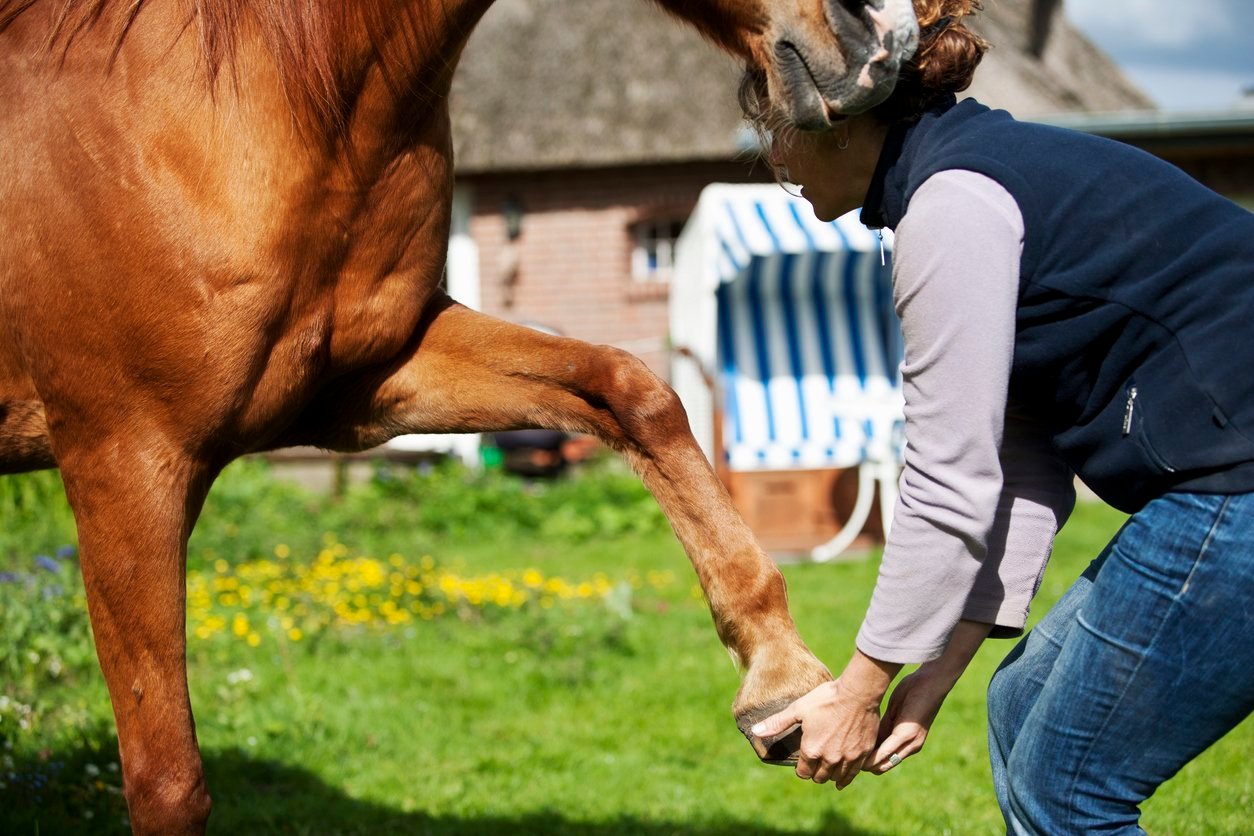
There are plenty of types of horse ligament injuries that are possible for your equine pal to encounter.
To keep it concise, we’ll cover a few of the most common key horse ligament injuries here.
Check Ligament Injury Horse
A check ligament injury can be tricky to diagnose without an expert eye since it’s so close to other vital structures. It usually requires veterinary intervention to diagnose. Check ligament injuries most often affect the inferior check ligament of the front leg, but it’s not impossible for the other check ligaments to be injured, too.
Check ligament injuries also commonly affect horses over ten years old.
Symptoms of this painful ligament injury horse include:
- Lameness that develops suddenly
- The area is hot to the touch
- Touching the area causes pain
- Tendon swelling in the upper cannon area
Check ligament injuries can develop quickly, and the injury is often acute. However, chronic cases can also occur and typically present as repeated strains overtime on the ligament.
Treatments aim to reduce inflammation for ligament injury horse can include:
- Cold water hydrotherapy and ice therapy
- Support devices, wraps, and bandages
- Joint supplements
- Non-steroidal anti-inflammatory medication
- Stall rest
- Exercise programs
- Joint injections
It may take up to 6 months for ligaments to fully heal. Throughout the recovery period, ultrasound scans are a helpful way to gauge the healing process and provide a prognosis on when a horse can return to work.
Collateral Ligament Injury Horse
Your horse has a wide range of collateral ligaments in their body, so it is no surprise that an injury to a collateral ligament in a horse can be caused by different things. For instance, the fetlock joints can be injured – but that will impact the collateral ligaments in these areas differently than those in their feet or hooves.
However, it is more common that a collateral ligament injury in a horse occurs in its hock area. Sprains and ruptures of the medial collateral ligament are more common than those of the lateral collateral ligament. Still, the lateral collateral ligament can become inflamed and injured, too, through strain.
Depending on where the injury occurred, your horse can experience different symptoms:
- Irritation
- Lameness
- Inability to bear weight on the leg or hoof
- Gait changes
- Swelling in the area
- Inflammation
Treatment for collateral ligament injuries in a horse varies, but one way to support your vet’s recovery plan is to feed your horse a joint supplement like TRI-ACTA and TRI-ACTA H.A.
TRI-ACTA H.A. for Pets
Our maximum strength formula is optimally designed to accelerate the formation of cartilage, minimize inflammation, expedite the healing process, and improve joint conditions.
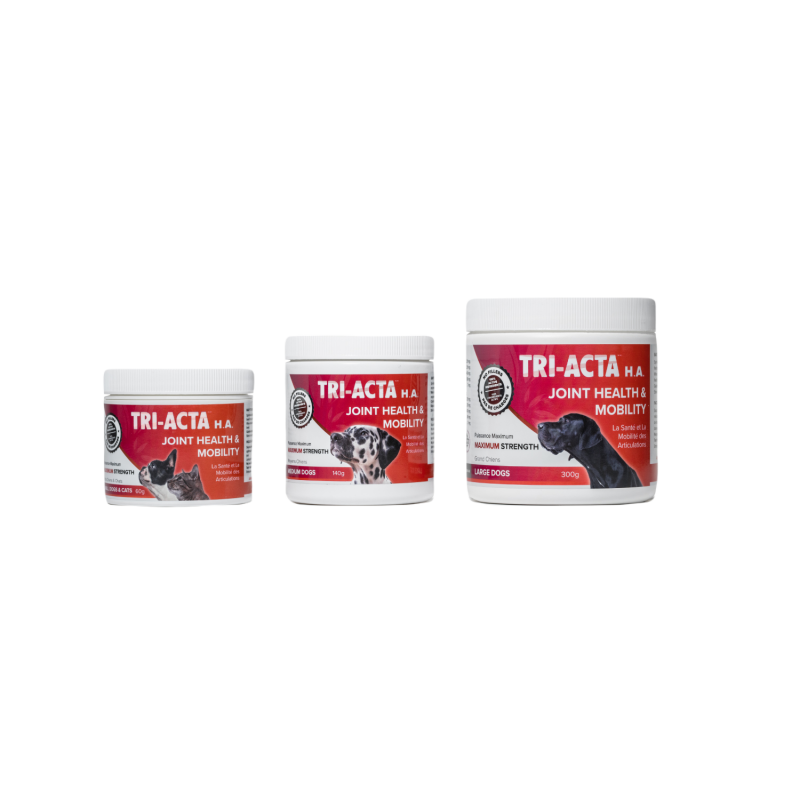
Suspensory Ligament Injury In Horse
Since a horse’s suspensory ligament absorbs shock and supports its weight when it runs and jumps, you could say it is a pretty important part of your horse’s overall motion! That also means it is susceptible to injury.
When a horse lands wrong after a fence, for instance, you may notice some tell-tale signs of a suspensory ligament injury in horse:
- Feels hot to the touch
- Swelling
- Discomfort
- Lameness (from mild to severe)
- Inability to move forward
The symptoms of a suspensory ligament injury can vary depending on where exactly, and how severe the injury is. When you spot the signs we listed above, it’s time to call the vet because it can mean serious trouble for your horse. They can provide appropriate treatment, including medication and physical therapy.
Horse Tendon & Ligament Injury Prevention
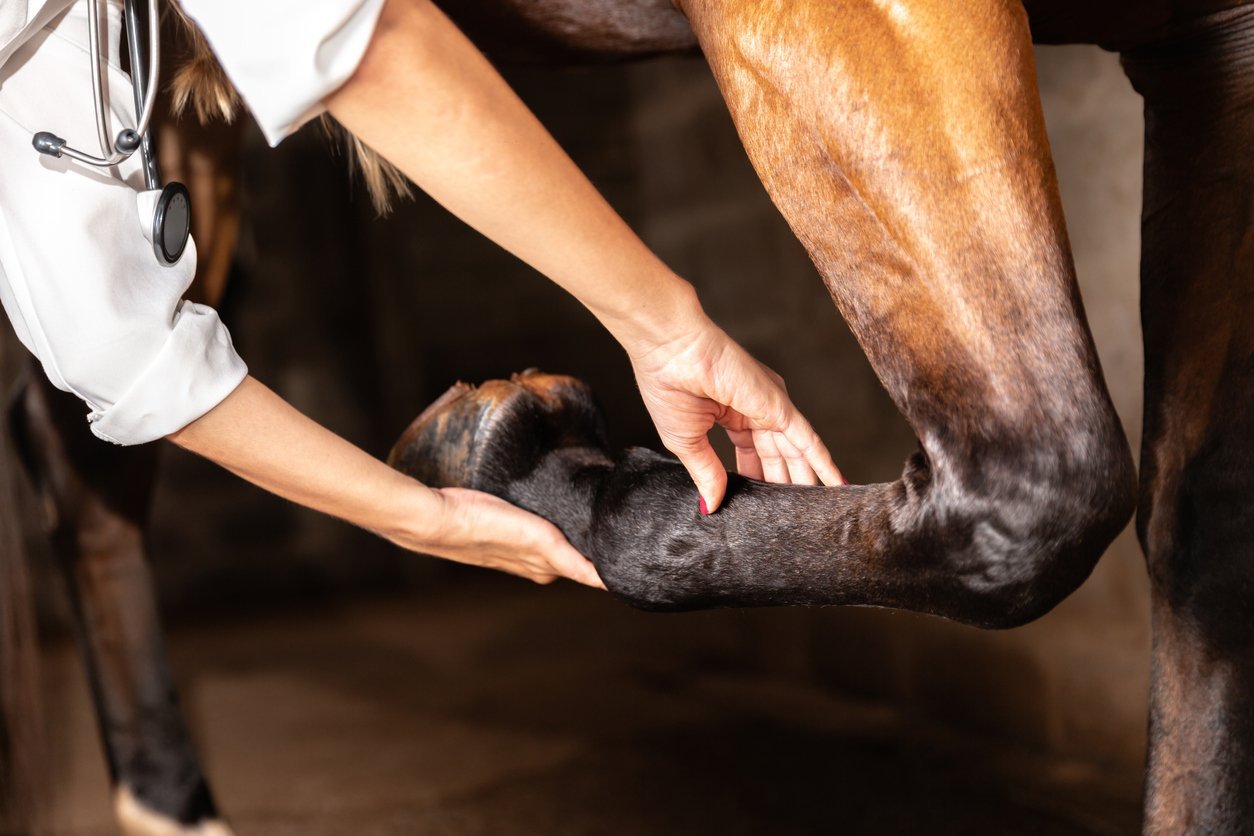
When it comes to preventing injuries, you want to do everything you can to help make your horse safe and comfortable
The best way to do that?
Well, it depends on your specific horse’s needs and what feels best for their age, weight, and medical history. You can always ask your vet what is best for your equine pal’s needs.
For a quick primer, we’ll go over three groups of solutions for tendon injury horse problems:
- Prescription medications and treatments
- Horse ligament supplements
- Alternative therapies
Okay, let’s get into it!
Prescribed Horse Ligament Medicine
When treating mild ligament and tendon injuries in horses and therefore preventing more serious ones from happening, your vet may feel prescribing your horse medication or a topical prescription cream is best.
It may seem like an aggressive option, but for older horses or those who have been injured in a sport before, it may be the best option to keep your horse comfortable.
The table below outlines the best horse ligament medicine options for equines.
| Horse Ligament Medicine | Pros | Cons |
| Non-steroidal anti-inflammatory drugs (NSAIDs) |
|
|
| Topical Creams (such as diclofenac liposomal cream) |
|
|
Your vet will help you determine which options are best for your horse.
Horse Ligament Supplements
For horses, like us humans, health starts from the inside. And building stronger healthier joints, muscles, and soft tissues is key to preventing new or worsening horse ligament injuries.
A high-quality, third-party lab-tested product like TRI-ACTA for equine can do just that!
With ingredients that are aimed at protecting and rejuvenating cartilage, it can help support healthy, strong horse tendons and ligaments. That way, they are better prepared to handle an injury and recover faster.
The best ingredients in a horse supplement to look for are outlined in the table below.
| Horse Supplements for Tendon Injuries Ingredient | What It Does |
| Glucosamine | Helps to repair the horse’s cartilage and tissues |
| Chondroitin | Contributes to the prevention of the breakdown of cartilage |
| MSM | Relieves pain and inflammation |
| Hyaluronic Acid | Increases the viscosity and quality of the synovial fluid |
Other Therapies
Sometimes, you need to think outside the box to keep your horse healthy!
Emerging therapeutics and modalities are great ways to approach your horse’s healthcare and prevent tendon injury horse problems.
Some methods of horse tendon preventative care include:
- Physical therapy
- Ultrasound therapy
- Laser therapy
- Hydrotherapy
- Cold therapy
- Extracorporeal Shock Wave Therapy (ESWT)
Again, always consult your vet before trying new therapeutic modalities in case it isn’t suitable for your horse’s unique needs.
Summary
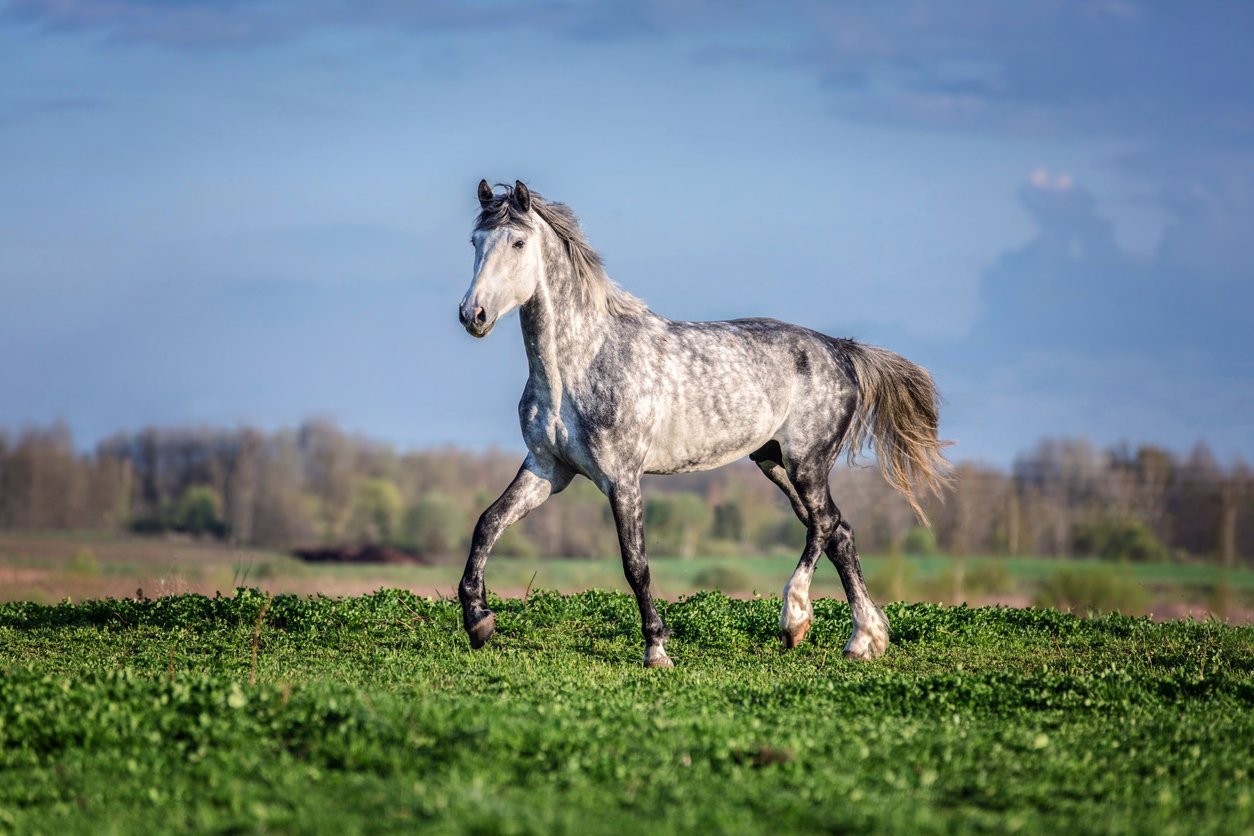
Tendon and ligament injuries are a common malady of large animals, including horses and other livestock. This injury is the result of repetitive strain on tendons or colliding forces placed upon a ligament. There are many types of tendon and ligament injuries, each with its own treatment protocols. Veterinary professionals have developed various modes of treatment for these maladies, so you know you don’t have to worry about your horse’s well-being alone.
And with all the information we have covered in this post, you know you’re ready to face any kind of ligament and tendon injury horse problems.
Now you can relax – without fear, even if your horse decides to stirrup trouble!
Newsletter Signup
Subscribe to our newsletter to receive the latest news and exclusive offers.
.jpg?height=2000&name=Cliick_Integricare-DISPLAY-REVISEDV2%20(1).jpg)
Proactive & Therapeutic Joint Supplements
When given daily, Integricare joint supplements recover bone and joint injuries faster and help prevent mobility injuries from happening in the first place.








